To most, the idea of fighting a nuclear war seems absurd — the assumption being that a nuclear balance provides stability, writes Paul Rogers. But this has never been the case.
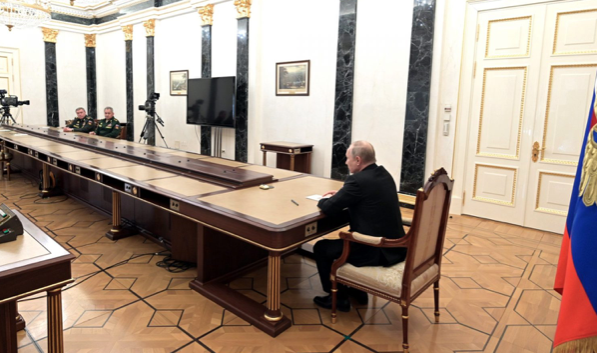
Russian President Vladimir Putin puts nuclear forces on high alert, Feb. 27. (Kremlin)
By Paul Rogers
Declassified UK
 Nuclear weapons have come back to center stage with Russian President Vladimir Putin putting Russian forces on nuclear alert over Ukraine. The war is not going according to plan and as the Kremlin escalates it to leveling cities, the demand across Europe and beyond for a NATO no-fly-zone is growing.
Nuclear weapons have come back to center stage with Russian President Vladimir Putin putting Russian forces on nuclear alert over Ukraine. The war is not going according to plan and as the Kremlin escalates it to leveling cities, the demand across Europe and beyond for a NATO no-fly-zone is growing.
Putin’s nuclear threat is designed to discourage NATO from implementing any such thing. [Ed.: Russia says its operation is not stalled, but carefully measured, despite Western media reports, conducted with a diplomatic track, which if it fails, could see a more fierce Russian attack.]
For most the idea of fighting a nuclear war seems absurd, the assumption being that a nuclear balance provides stability through “mutually assured destruction.”
But this has never been the case.
Since the start of the atomic age in 1945, nuclear arms have been seen by powerful states as useable weapons and appropriate in certain circumstances for fighting ‘limited’ nuclear wars.
This is the case with NATO as an alliance — and individually with the U.K. and France — so it would be rash to presume Russian nuclear planning isn’t similarly organized.
Indeed, much of the drive behind the new U.N. Treaty on the Prohibition Against Nuclear Weapons, which already has 56 signatures, was this fear of nuclear instability.
At the start of the nuclear age in 1945, atomic bombs were seen as the direct descendants of the conventional weapons that had been used during the Second World War for aerial attacks on cities such as Dresden and Tokyo, where tens of thousands of people were killed.
By 1948 the United States had an arsenal of 50 atom bombs. Russia tested its first in 1949 and both began to develop the far more powerful H-bomb.
Britain’s Tactical Nuclear Arsenal
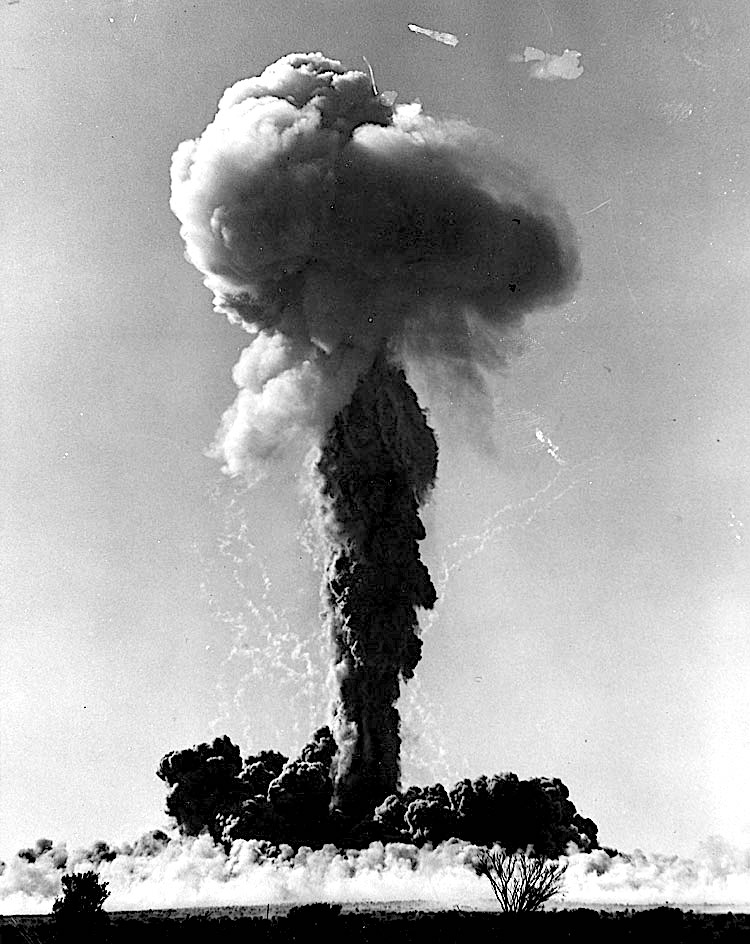
Oct. 11, 1956: Valiant B.1 WZ366 of No. 49 Squadron became the first British aircraft to drop a live atomic bomb during the Buffalo R3/Kite test at the Maralinga site in South Australia. (U.K. government, Wikimedia Commons)
The U.K. came on the scene a little later. It first tested a nuclear weapon in 1952 and by the end of that decade could start deploying its nuclear-capable Valiant, Vulcan and Victor strategic bombers.
These, too, were seen in the context of British involvement in the area bombing of German cities. But Britain was also an early adherent to the idea of fighting limited nuclear wars, an issue particularly relevant in the Middle East and Asia towards the end of empire.
There were nuclear-capable Canberra bombers and nuclear weapons deployed to RAF Akrotiri in Cyprus from 1961 to 1969 to support the Central Treaty Organisation (CENTO), the southwest Asian equivalent of NATO. These were replaced by Vulcans in 1975.
From the mid-1960s there were regular detachments of V-bombers to RAF Tengah in Singapore. The Royal Navy also had nuclear-capable Scimitar and Buccaneer strike aircraft on aircraft carriers such as Eagle, Ark Royal, Centaur and Victorious over a 16-year period from 1962 to 1978.
The role of British nuclear weapons was expressed by Harold Macmillan in 1955, when he said: “The power of interdiction upon invading columns by nuclear weapons gives a new aspect altogether to strategy, both in the Middle East and the Far East.”
Macmillan, who was then defence minister, felt such a tactic would afford “a breathing space, an interval, a short but perhaps vital opportunity for the assembly, during the battle for air supremacy, of larger conventional forces than can normally be stationed in those areas.”
Two years later, Macmillan’s successor Duncan Sandys said: “Limited and localised acts of aggression, for example, by a satellite Communist State could, no doubt, be resisted with conventional arms, or, at worst, with tactical nuclear weapons, the use of which could be confined to the battle area.”
Acceptable in the 80s
The idea of usable nuclear weapons persisted through the decades and by the early 1980s Britain’s nuclear arsenal had grown to several hundred warheads.
At the strategic level there were the Polaris submarine-launched nuclear missiles. At the shorter-range tactical level there was the WE177 bomb that could be delivered by the RAF’s Buccaneer, Jaguar and Tornado strike aircraft.
The Royal Navy had Sea Harrier aircraft for the WE177 and helicopters to carry an anti-submarine variant. Even a helicopter flying from the Navy’s smallest frigate, the Type 21, was nuclear-capable.
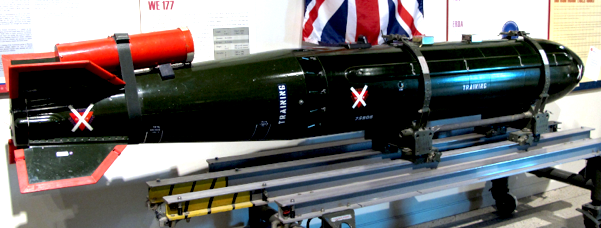
A WE 177 bomb at the National Museum of Nuclear Science & History. (Kelly Michals/CC)
Britain’s arsenal did not even end there, as four different U.S. nuclear warheads were available for use under a dual control system.
One was a nuclear depth bomb carried by Nimrod maritime patrol aircraft; another was carried by the army’s short-range missile; and the final two were nuclear shells to be fired from 155mm or 203mm artillery.
With the end of the Cold War most of these were withdrawn in the 1990s, leaving the U.K. with just the Trident submarine-launched missile system.
That, though can be fitted with either of two warheads, one for massive strategic use and the other a much lower-powered warhead but still nearly as destructive as the Hiroshima bomb.
Then There Was NATO

West Germany joined NATO in 1955, which led to the formation of the rival Warsaw Pact during the Cold War. (Bundesarchiv, CC BY-SA 3.0, Wikimedia Commons)
How does all this fit in with NATO? As one of the founding members of the alliance, Britain was involved in its nuclear planning from the mid-1950s.
In that period, NATO nuclear policy was codified in document MC14/2, known as the “tripwire” policy which planned a massive nuclear response to the initiation of war by the Soviet bloc.
By the latter part of the 1960s, the Soviet Union had developed its own array of tactical systems and NATO responded by modifying the “tripwire” and developing what it called a “flexible response.”
This envisaged the limited use of mostly low-yield warheads early in a conflict against Warsaw Pact troops in the belief that they might be “stopped in their tracks.” If that failed, a more general nuclear response might ensue.
Britain was very much part of this move. Its nuclear forces were normally committed to NATO and U.K. personnel played significant roles within the alliance’s Nuclear Planning Group.
This move away from deterrence through mutually assured destruction was rarely publicized by the British government.
It was not until two decades later that the Ministry of Defence told parliament’s Foreign Affairs Committee:
“The fundamental objective of maintaining the capability for selective sub-strategic use of theatre nuclear weapons is political — to demonstrate in advance that NATO has the capability and will to use nuclear weapons in a deliberate, politically-controlled way with the objective of inducing the aggressor to terminate the aggression and withdraw.”
First Use
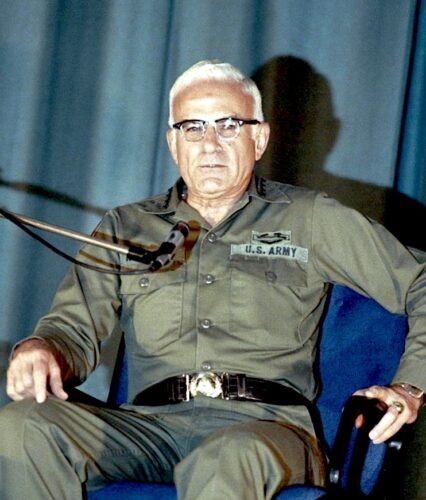
General Bernard W. Rogers in 1983. (Dutch National Archives, CC BY-SA 3.0, Wikimedia Commons)
NATO was not just prepared to use nuclear weapons first in response to a conventional military attack from the Soviet bloc. It was willing to do so at a much earlier stage in such a conflict.
The Supreme Allied Commander of Europe, General Bernard Rogers, said in 1986:
“Before you lose the cohesiveness of the alliance – that is, before you are subject to (conventional Soviet military) penetration on a fairly broad scale – you will request, not you may, but you will request the use of nuclear weapons.”
The general’s comment chimes with what I was told by a senior German civil servant during a briefing for academics at NATO headquarters in the late 1980s. This man, who was seconded to the alliance’s Nuclear Planning Group, described with some enthusiasm a circumstance of potential first use.
If Soviet forces crossed the frontier into West Germany, he said an immediate and valid response would be to detonate up to five low-yield high-altitude nuclear warheads. This would be sufficient to cause the Soviets to halt their advance but insufficient to inflict widespread damage.
He really seemed to believe it would work.
‘Out-of-Area’ Operations

HMS Cardiff anchored outside Port Stanley, Falkland Islands, at the end of hostilities in 1982. (Griffiths911, CC BY-SA 3.0, Wikimedia Commons)
Britain has also been willing to use its nuclear arsenal in “out-of-area” operations, in conflict with countries far from NATO’s borders.
After Argentina occupied the Falkland Islands in early 1982, Margaret Thatcher dispatched a substantial naval task force. Six days after it left Britain, the Observer reported that: “It is almost certainly carrying tactical nuclear naval weapons – atomic depth charges carried by Sea King helicopters and free-fall bombs carried by Harrier jump jets — as part of NATO equipment.”
Later reports indicated that nuclear weapons from two destroyers were transferred en route to an auxiliary supply ship and the two aircraft carriers, Invincible and Hermes.
Declassified recently revealed that British ships carried 31 nuclear depth charges during the Falklands crisis. The weapons remained on the Task Force during the war and there were also multiple if unconfirmed reports that the Thatcher government was prepared to deploy a Polaris missile submarine to the mid-Atlantic to bring it within range of Argentina.
Nine years after that war, the U.K. government committed substantial forces to a U.S.-led multinational coalition to evict the Iraqi forces that had invaded and occupied Kuwait in August 1990.
There was considerable concern that Iraq had a useable arsenal of chemical weapons. A senior British army officer attached to the 7th Armoured Brigade which was leaving for the Gulf clearly indicated Britain was willing to retaliate with nuclear weapons.
He confirmed that an Iraqi chemical attack on U.K. forces would be met with a tactical nuclear response. Similar threats were made at the onset of the 2003 Iraq war.
Deliberate Ambiguity
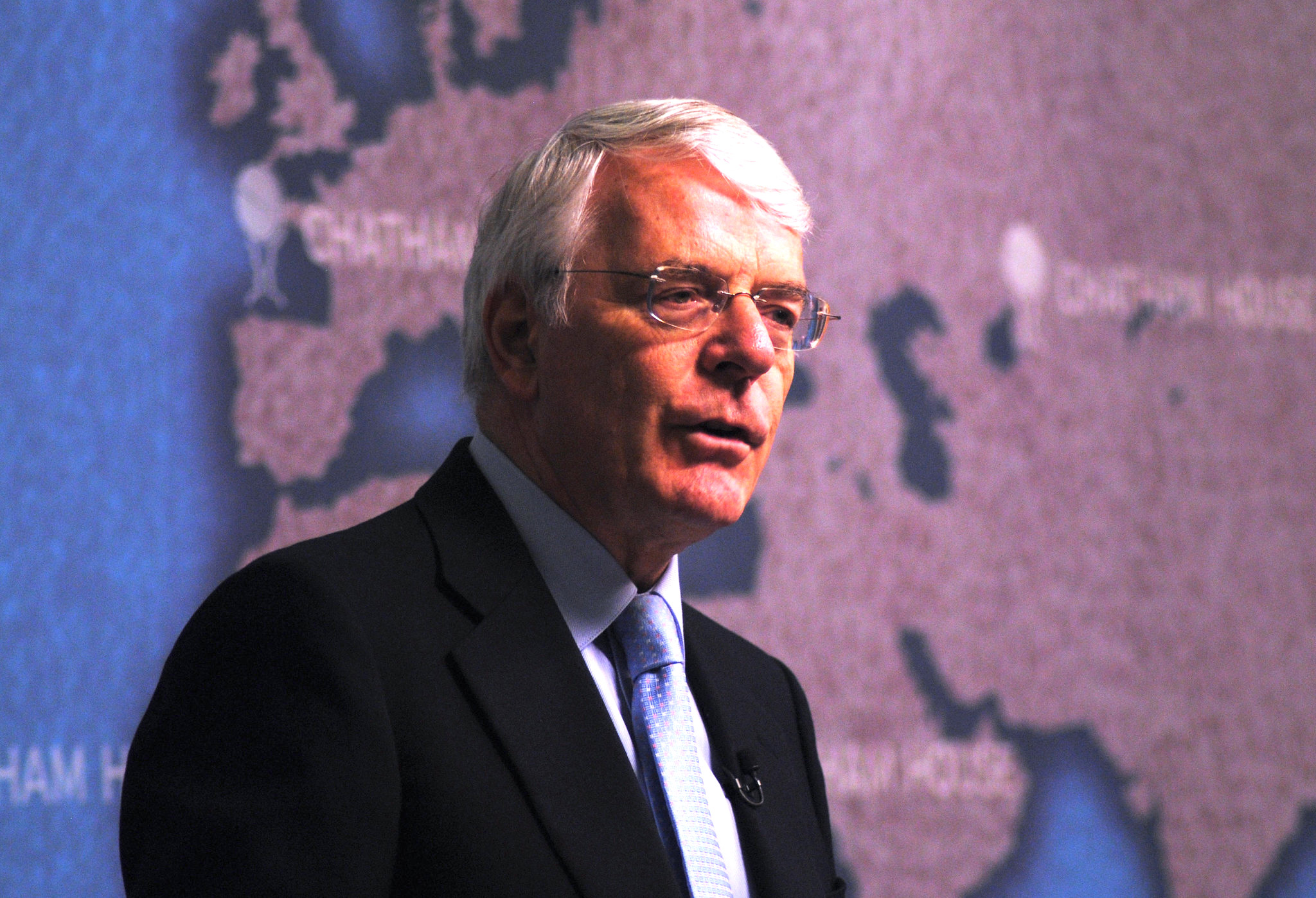
John Major in 2013. (Chatham House, Flickr, CC BY 2.0)
After the end of the Cold War, Conservative Prime Minister John Major scaled down Britain’s nuclear arsenal in a series of unilateral moves.
He ceased deployments of dual-control U.S. nuclear artillery and missiles, and withdrew the WE177 tactical nuclear bombs and depth bombs between 1992 and 1998.
But in order to preserve a British “sub-strategic” capability, a low-yield variant of the standard high-yield Trident thermonuclear warhead has since been deployed.
There was a period from the early 1990s to 2010 when successive governments, both Conservative and Labour, were fairly open about the size of the U.K. nuclear arsenal, including plans to decrease the overall arsenal.
That ended a year ago with a new policy announcing an increase in the number of nuclear warheads for the Trident submarine fleet.
The new U.K. policy also threatens to use nuclear arms against non-nuclear weapons states that are said to be heading in the direction of acquiring nuclear weapons — or, as the government puts it, those states judged to be “in material breach of [their] non-proliferation obligations.”
A generic description of the U.K. nuclear posture previously appeared in successive defence white papers. The 2015 statement stated:
“Only the Prime Minister can authorise the launch of nuclear weapons, which ensures that political control is maintained at all times. We would use our nuclear weapons only in extreme circumstances of self-defence, including the defence of our NATO Allies.”
It added: “While our resolve and capability to do so if necessary is beyond doubt, we will remain deliberately ambiguous about precisely when, how and at what scale we would contemplate their use, in order not to simplify the calculations of any potential aggressor.”
Low-Yield Warheads
That still leaves the issue of under what circumstances might the U.K. initiate the first use of nuclear weapons. Successive British governments have studiously avoided speaking in specific terms.
However, a useful guide to the low-yield warheads in the Trident program was published in the mainstream military journal, the International Defence Review in the mid-1990s, and also fits in with NATO’s nuclear posture.
This noted that: “At what might be called the ‘upper end’ of the usage spectrum, they could be used in a conflict involving large-scale forces (including British ground and air forces), such as the 1990-91 Gulf War, to reply to an enemy nuclear strike.”
“Secondly”, it noted “they could be used in a similar setting, but to reply to enemy use of weapons of mass destruction, such as bacteriological or chemical weapons, for which the British possess no like-for-like retaliatory capability.”
And “Thirdly, they could be used in a demonstrative role: i.e. aimed at a non-critical uninhabited area, with the message that if the country concerned continued on its present course of action, nuclear weapons would be aimed at a high-priority target.
“Finally, there is the punitive role, where a country has committed an act, despite specific warnings that to do so would incur a nuclear strike.”
The options outlined here fit well with what is implied in NATO’s flexible response strategy and relate to Britain’s view of the potential role of nuclear weapons that goes back to the 1950s.
What is striking is that three of these options noted above involve the first use of nuclear weapons, and the final two are uncomfortably close to the threat implied by Putin on Feb. 27.
If the Ukraine crisis ends soon and an even more devastating conflict is avoided, an immediate priority must be facing up to the issue that many states regard nuclear weapons as useable.
Being serious about the U.N. nuclear weapon ban and joining those many states that have already signed up would be a very good start.
Paul Rogers is an emeritus professor of peace studies at Bradford University and a visiting fellow at the Joint Services Command and Staff College.
This article is from Declassified UK.
The views expressed are solely those of the author and may or may not reflect those of Consortium News.

Paul Rogers outlines a very useful timeline of UK in NATO and nuclear weaponry and strategy development – hopefully usual USA approach of ‘all options are on the table’ is not on the table this time.
As for not going to plan, what war ever does? This is not ‘Blitzkrieg’. A few days ago, the Russians claimed to have hit over 3,500 military and ‘strategic’ targets while Ukraine claimed that 2,500 military personnel killed. This signifies anything other than a ‘loose cannon’ approach to the ‘military operation’.
Ukraine claims that many more civilians have lost their lives but when the government hands out AK47s and Molotov Cocktails to anyone over 16 and NATO ships in handheld anti-tank and air missiles for use by very irregular army, they are wilfully setting up a cocktail of mayhem. Russia is not targetting civilians as can be seen from the continuous running of the rail line from Kiev to Lviv and beyond – safely carrying three prime ministers in and out of Kiev today.
Hopefully the on-going talks will soon bring a ceasefire and peace.
“The war is not going according to plan and as the Kremlin escalates it to leveling cities, the demand across Europe and beyond for a NATO no-fly-zone is growing. ”
I found the rest rather needless after this lie. He is concerned with peace???
Pres. Putin has always insisted that the Russians will NOT have a nuclear first strike, which the USA has NOT promised- in fact wants to use “little nukes”.
However, IF the USA should dare to make a first strike, the response would be swift and final- “we will go to heaven as martyrs, you will just drop dead without having time to repent!!!!!”
“what use would the world be without Russia?”
To Putin, the present NATO stand is an existential one for the survival of Russia. Facts on the ground show that he is right- hatred to an extreme level of all possible acts, needs, people,survival, future of Russia, any media daring to emanate from Russia is banned.
In what way is the USA’s position as decider of the future of us all a democratically arranged fact???
” It is difficult to know what to make of the rest of the article when the first paragraph makes an unwarranted that the invasion.. .” Yeh I kinda stopped there too. Not good.
In which way is it not going according to plan? The article doesn’t say. And “Kremlin levelling cities” ? The article doen’t say. No doubt suburban areas will be hit. But so long Poland tv news is showing ” dead civilians in body bags” which was really from a climate protest in Munich a x nr of years ago; so far; the nr of dead civilians seem hard to find – not that they are not there. No doubt. Civilians wil be hit. No doubt civilian housing and buildings will be hit. But where does the notion “levelling cities” cities come from?
To amplify Moses’ point: the author’s various UK and NATO ‘strategic’ nuclear postures relate only to intended first-use scenarios, including retaliatory moves to conventional and/or bio- and chemo-attacks that are unilaterally assessed to be ‘illegal.’ It leaves out highly discussed Wolfowitz-type fantasies, generally under the rubric of ‘from-MAD-to-NUTS,’ the latter meaning ‘Nuclear Utilization Targeting Strategies,’ recently ‘resurrected’ by fellow fantasists such as Adm. James Stavridis. Generally, these falsely assume that ‘smaller bombs are safer.’ They are not: all low- and ground-level nuclear blasts risk inestimable damages to the biosphere, where ‘we’ all live, with the obvious unintended blowback effects.
Then there is the ‘old’ problem of accidental nuclear war, where either manual or machine-commandeered mechanisms simply get the supposed ‘threat’ wrong. Needless to say, that risk increases with each warhead added to the world total. I summarized an early top study by Brian Crissey, a snippet of which is preserved here – I have the whole essay, should a statistician care to confirm his methodology:
hxxps://books.google.com/books?id=R2OSBgAAQBAJ&pg=PA3&lpg=PA3&dq=cybernetics+culpability+and+risk+automatic+launch+and+accidental+nuclear+war&source=bl&ots=UolGgUH_x1&sig=ACfU3U0PF2NM4jYmfRZg1KW8HnsdViWySQ&hl=en&sa=X&ved=2ahUKEwjLpN6_1sj2AhVFTd8KHc3mBYIQ6AF6BAguEAM#v=onepage&q=cybernetics%20culpability%20and%20risk%20automatic%20launch%20and%20accidental%20nuclear%20war&f=false
The current relevance, even of classic studies modeled on far lower arsenals, is obvious. While the official Biden team posture is that NATO’s violating of Ukrainian (or Russian) airspace may well mean WWIII, they nonetheless pour everything short of nuclear warheads into the volatile mix. Not a good prognosis.
“…when the first paragraph makes an unwarranted that the invasion is not going according to plan, and a factual falsehood that Russia is leveling cities.”
To which to add :
Paul Rogers is an emeritus professor of peace studies at Bradford University and a visiting fellow at the Joint Services Command and Staff College.
Perhaps the gentleman is writing now for a purpose which does not necessarily reflect his “assumptions”.
The latest update about 18 months ago of the nuclear doctrine of the Russian Federation, was in regard to nuclear response to biological warfare attacks on the Russian Federation, without specifying the level of response, whilst circa 6 months before that adjustment, the Russian Federation published data on securing of biological ethnic specific samples by “The United States of America” and its “United Kingdom” associates at Porton Down, and their joint bio chemical warfare activities over a number of years.
This whole matter has recently been given added priority by the People’s Republic of China and the Russian Federation.
Perhaps this article is not unrelated ?
Paul Rogers – Thanks, but you do not seem to have realized that Russia’s hypersonic missile arsenal has thrown a wrench into Mutual Assured Destruction (MAD) – the assumption that all-out nuclear war between superpowers would destroy the military capacity of both the attacked and the attacker. As put by Mark Lewis, Executive Director of the National Defense Industrial Association’s Emerging Technologies Institute, hypersonic missiles are the wrench:
“There’s a practical reality that every time we did war games and analysis, if the United States did not have hypersonic capabilities in certain important scenarios, we didn’t win … It was as simple as that.”
Unfortunately for Ukraine and NATO, the United States does not have hypersonic capabilities in any important scenario (neither defensive nor offensive), and it cannot intercept in-coming hypersonic missiles. That practical reality has converted MAD into Asymmetrical Assured Destruction (AAD) – a scenario where one side suffers complete destruction of its military capacity while the other side suffers only nearly-complete destruction of its military capacity. Biden and Austin know that the current imbalance in hypersonic capacity favors Russia. Thus we have the otherwise perplexing decision that the United States will not allow Poland to fly Mig-16 fighter jets to a U.S. military base in Germany for delivery by U.S. pilots to Ukraine through “contested airspace.” As Lewis said, the U.S. would not win WWIII without deployable hypersonic capabilities. It is as simple as that.
The problem for the UK is that it has (like the USA) only two political parties of any significance which have almost identical policies and which rotate power between them. Both have always been deeply committed to the possession and presumably the first use of nuclear weapons. Until we can create democracy in the UK and thereby enable working people’s voices to be heard against the militaristic clamour of the corporate media, there is unlikely to be any significant change to the UK’s nuclear weapons capabilities other than what we have now: a large increase. Six decades of campaigning by CND have been unable make any difference. I ask readers for suggestions to change this.
“Nine years after that war, the U.K. government committed substantial forces to a U.S.-led multinational coalition to evict the Iraqi forces that had invaded and occupied Kuwait in August 1990. ”
Sadly, there is good reason now to think that Iraq was deliberately encouraged by the administration of George H.W. Bush to invade Kuwait so that an excuse could be found to attack and destroy much of Iraq’s military capability.
Ambassador April Glaspie:
“We have no opinion on your Arab-Arab conflicts, such as your dispute with Kuwait. Secretary Baker has directed me to emphasize the instruction, first given to Iraq in the 1960s, that the Kuwait issue is not associated with America.”
Botched diplomacy or deliberate contrivance?
It is difficult to know what to make of the rest of the article when the first paragraph makes an unwarranted that the invasion is not going according to plan, and a factual falsehood that Russia is leveling cities. They are verifiable not.
Yet, nuclear war is indeed an absurdity. But perhaps to the criminally insane it may not seem so. Washington and it’s perpetual war economy has been stepping back from every disarmament treaty for the past two decades and a $1.3 trillion upgrade to nuclear weapons was committed to by no other than our Nobel Peace Prize winner, President Obama.
I agree with you that it is untrue to claim that Russia is ‘levelling cities’ but it seems pretty obvious that the invasion is not going as Putin expected. However, NATO-US is still unlikely to attempt direct confrontation because of the nuclear risk and because a long war in Ukraine, no matter how many Ukrainians die, is to the advantage of the USA which has long wanted to change the regime in Russia to one more Western-friendly.
That was exactly what struck me. Russia is trying to minimise civilian casualties and gradually surrounding the Ukrainian forces. Putin putting Russia’s nuclear weapons on high alert, was, as he explained, in response to the Liz Truss remarks which revealed what an utterly stupid woman she is.
” Russia is trying to minimise civilian casualties and gradually surrounding the Ukrainian forces.”
That is correct and largely because Russia has a different culture, which opponents seek to misrepresent through projection as just like us, and hence try to misrepresent Russia’s strategical patience as failures/defeats.